The Science Behind Low-Level Light Therapy (LLLT) for Hair Regrowth
When it comes to promoting thicker, fuller hair, Low-Level Light Therapy (LLLT) with red and near-infrared wavelengths has received growing attention—and for good reason.
Research shows that specific light wavelengths can help stimulate hair follicles at the cellular level, leading to meaningful improvements in hair count and scalp coverage over time. A 2021 systematic review notes that “photobiomodulation therapy with red or near-infrared light has shown promising results” for individuals dealing with androgenetic alopecia (Pattern Hair loss). (See Study 1)
In multiple studies, including those by Lanzafame et al. (see studies 2 & 3), researchers observed that participants who used LLLT devices experienced a significant increase in hair density compared to control groups. This effect is often attributed to the way red and near-infrared wavelengths interact with mitochondria—the “powerhouses” of the cell. According to evidence summarized in another review, “increased mitochondrial activity supports better cell metabolism and can encourage follicles to shift into the active growth phase”. (See Study 4)
Additionally, enhanced blood flow appears to play a crucial role in these results. When the scalp absorbs red and near-infrared light, tiny blood vessels may dilate, delivering more oxygen and nutrients directly to hair follicles. An article published in 2021 highlights that “improved microcirculation in the scalp contributes to stronger, healthier hair growth”. This is particularly beneficial for those dealing with pattern hair loss, where follicles gradually weaken over time. (See Study 5)
Most protocols in the studies reviewed recommend using LLLT devices for relatively short sessions—often 10 to 20 minutes—several times a week. Participants typically begin to see visible changes in hair thickness after three to six months of regular use, although some individuals may require longer periods for optimal results. A randomized, sham device-controlled trial underscored these findings, showing that consistent light therapy not only increases hair count but also helps maintain results over time. (See Study 6)
What makes this technology particularly appealing is its safety profile. Side effects reported in these trials have been minimal, typically involving only mild scalp irritation or warmth. Unlike more invasive or chemically based options, red and near-infrared LED therapy is generally considered non-invasive, with no significant downtime. This aligns with the conclusion of several researchers who describe LLLT as an “effective and well-tolerated solution” for addressing hair thinning, especially for those with androgenetic alopecia (Pattern Hair loss).
By applying these scientifically backed wavelengths directly to the scalp, devices such as the RootRevival Crown aim to deliver the benefits of LLLT in a user-friendly format. The underlying concept is simple yet powerful: energize your follicles from within, give them a healthier environment to grow, and maintain this regimen consistently. Over time, the improvements can be significant—leading many users to regain not just hair, but confidence as well.

RootRevival Crown - Red Light Therapy for Hair Growth
RootRevival Crown - Red Light Therapy for Hair Growth






